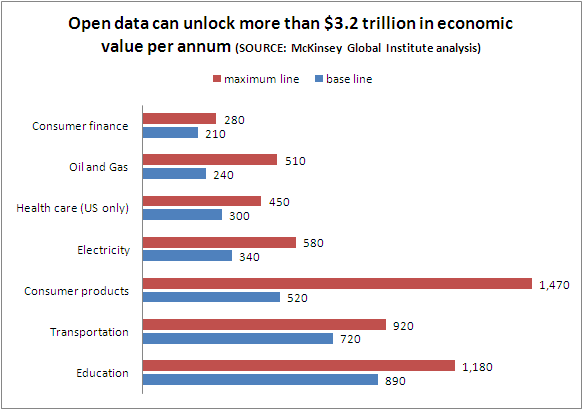- Home ›
- Data Protection ›
- Big Data Tools
How Big Data Tools Will Revolutionize Communication Logistics
IN BRIEF: The communication logistics industry is on the brink of adopting big data tools to revolutionize business processes, making them faster, smarter and more efficient. They are following the path carved out by digital companies such as Google, Amazon, Facebook and eBay. Many hurdles need to be overcome on this journey - personal information ownership issues, data protection & quality, technical feasibility, to name just a few. Data has become the 4th production factor, after human resources, capital and commodities, and as entrepreneurial communication logistics providers start to exploit this asset, it will become essential to competitive success.
If we look
at how the communication logistics industry consumes and produces data, it's
clear that the core business model has changed over the past decade – from item-driven
to data-driven.
Access to,
and analysis of, massive quantities of data from a variety of sources makes
predictions possible. This opens up the potential for huge increases in operational
efficiency.
This
revolution has its greatest impact in last mile delivery - the most expensive
part of the logistics value chain. Big data tools provide an exponential
increase in the ability of IT to raise efficiency levels, driving down costs in
last mile delivery.
Big Data
analytics are used to focus on 2 major aspects of the delivery model:

- Massive quantities of data are processed to increase delivery fleet performance. This is achieved through real-time optimization of delivery routes, taking the traffic, weather and customer status into account. Smart delivery vehicles, supplied with optimised, real-time routing information are the result.
- Big Data tools allow a more holistic approach to last-mile delivery models. For example, the capacity of a huge crowd of people moving randomly can be harnessed to replace the current delivery workforce & to include alternative pick-up and drop-off locations (myways, checkrobin).
Big Data tools help network & operational planning
There is great interest in improving distribution and operational planning.
Big Data analytics can help reduce excess capacities, which lower profitability, and avoid capacity shortages, which impact service quality and put customer satisfaction at risk.
The network:
Network planning and optimization can be achieved by analyzing available historic data, using data generated at tracking events and related data from transportation routes.
In addition, externally available data, such as seasonal factors, flow trends and regional economic information, creates a more accurate prediction of capacity demand.
As a result over-capacity is quickly identified, dynamic pricing can be supported, identified overheads either made flexible or traded in a spot-market-like environment.
Operations:
Operational planning already takes place almost in a real-time
environment. This covers capacity planning for trucks, trains, aircraft as well
as for staff sorting or distribution centres.
Using advanced Big Data analytics, the changing conditions inside and outside the distribution network can be calculated in advance. Real-time information on items (entering, in transit or stored) are aggregated and used to predict the allocation of resources within the next 2 days.

Data can be collected from customers preparing to insert items into the network, sensors tracking data from items within the network, or management information systems deployed to monitor production systems, and interaction with third party service providers (aviation, customs, etc.).
Further upward integration into externally available customer information (upcoming product releases, sales forecasts, financial indicators) and local incidents (social economical indicators, such as natural disasters, regional health related challenges) can change demand figures for a region or product.
Data analyzed in such a way can be applied in an almost real-time environment, allowing predictive decisions and raising efficiency dramatically.
As Big Data tools help us to see the overall picture, they also help reveal the congestion on routes and production sites which cannot be achieved at a local level.
Individual customer insight is key in increasingly competitive markets
It costs far more to win a new customer than retain an existing one.
Postal incumbents in a changing communication logistics environment find it increasingly difficult to trace and analyze individual customer satisfaction.
In the past, sales and customer care have not been the core focus of postal services. As postal services became data-driven businesses, usually the individual customer has been subsumed into a large and anonymous customer base.
When it comes to effective customer retention policies, Big Data tools enable customer satisfaction to be sustainably assessed by merging multiple and extensive data sources.
The result is a combined evolution of records from customer data points, such as operational data on service quantity and quality and external data (sales records, customer financial data, social media reports, etc.).
1. Increasing customer loyalty:
Applied correctly, Big Data analytics can be used to determine the attrition potential of every customer with automated techniques such as semantic text analytics and pattern recognition.
This then enables proactive counter-measures and loyalty programs,
designed to retain the individual customer.
But it’s not enough to focus purely on the sender, the service provider’s primary customer.
Recipients are affected by poor execution in delivery, and recurring customer complaints result in vendors switching to alternative service providers. Logistics providers need to include the recipient in future loyalty management models, especially in B2C markets.
2. Continuous service improvement:
To date, CRM
systems and market surveys have been the single source of data for service
improvement and product innovation.
Today Big Data tools provide access to gigantic amounts of customer-centric information on public sites. Using semantic analytics and text-mining, automated customer-related feedback can be gathered from huge text and audio repositories.
This publicly available feedback on quality and demand can also be broken down by socio-demographic and ethnic data; making it possible to evaluate whether an occurrence is a one-time incident, related to initiated actions, or represents a sustained trend.
Logistics as a macroeconomic indicator
Logistics are often used as an indicator of future economic development.
Volumes of shipped goods
indicate regional levels of demand and supply. It is therefore unsurprising that
several financial indices measure the macroeconomic impact of the logistics
sector (Baltic Dry Index; Dow Jones Transportation Average, etc.).
The Big Data available to logistics providers allows them to extract microeconomic insights from the flow of goods through their logistics network.
Big Data for market intelligence, financial and supply chain analytics
Without compromising postal privacy, logistics providers can provide an extensive source of market intelligence: the historical and real-time information in their databases can significantly enhance conventional demand and supply forecasts.

Big Data analytics tools have high predictive value. They can either be used for internal revenue and risk assessment, or offered as an additional market intelligence service to third parties:
- SMEs do not have the capacity to undertake their own market research; segmented forecasts by industry, region and product category can be conducted on their behalf.
- Rating agencies and advisory firms in banking or insurance benefit greatly from access to detailed information collected from global distribution networks.
A new revenue stream for the communication logistics industry?
Providing access
to this raw data could soon offer a new, highly profitable revenue stream for
the communication logistics industry.
Postal
logistics service providers deploy fleets of vehicles that are constantly on
the move within a geographically defined area. These vehicles can be used to
collect data and information on the go.
Address and
recipient verification is a prerequisite for ecommerce. The more important the authentication
of addresses, identity of recipients and personal attributes becomes, the more
logistics providers will enhance their mediator role, becoming trusted brokers
of authentication and e-Identity.
Their delivery model can also be extended to verifying data for retail, banking and public sector entities.

Fig. 1: Big Data can unlock more than US$ 3.2 trillion in economic value per annum (McKinsey).
Exploiting Big Data requires skills and change management
Over the past decade the change from item-driven to data-driven logistics has lead to substantial changes in the postal industry as a whole. Becoming a Big Data-driven company – one that uses Big Data tools to gain a competitive advantage – will require further, substantial business and technology developments.
Big Data handling is not simple. The key aspects involved are volume, variety and velocity:

- Big Data analytics relies on high data quality.
- Information assets and their ownership must be clear.
- Data attributes must be clearly structured and explicitly defined across multiple databases.
- Strong governance on data quality must be maintained.
"Big Data by design" - a core prerequisite:
Data
protection and privacy issues must be considered before the start of any Big
Data project, particularly because, when
gaining customer insight, personal information is often revealed.
Sector-specific postal data protection regulation and strict data protection law are not the only constraints - large-scale data collection and exploitation will engender public debate and can damage the reputation and brand value of those corporations involved.
The war for talent:
Mastering the many data analysis and manipulation technologies that turn huge quantities of raw data into valuable information is key to success, yet the required mathematical and statistical skill sets are scarce. A talent war is already under way with most leading corporations recognizing that they have to source missing data science skills externally.
Technology is changing the business case:
As computing power has increased exponentially in the last years, advanced data processing models and technologies have become available - In-memory data storage and distributed computer frameworks, just to name a couple. Adopting these technologies and adapting existing systems will become a business in itself.
Walter Trezek is the Chairman of the Consultative Committee (CC) of the Universal Postal Union (UPU).
- Home ›
- Data Protection ›
- Big Data Tools
Does this article cover a topic relevant to your business? Access the CLS Business Lounge for the market intelligence you need to stay ahead of the crowd. Find out more






